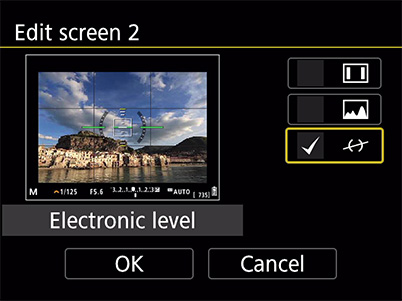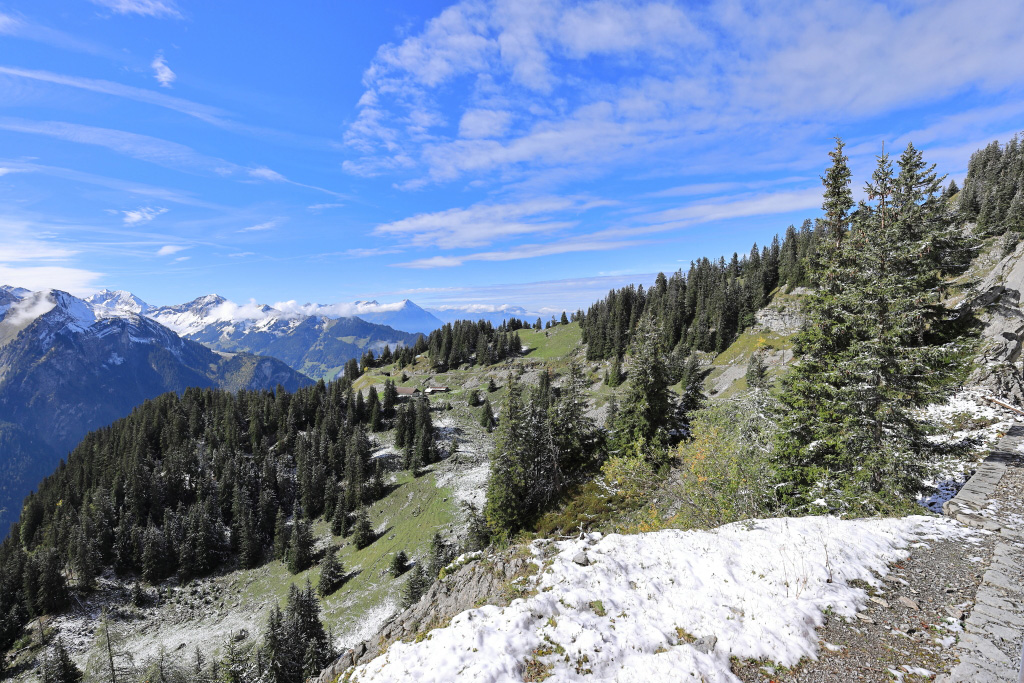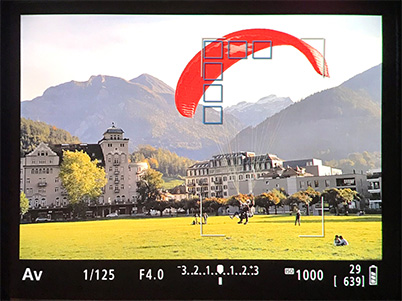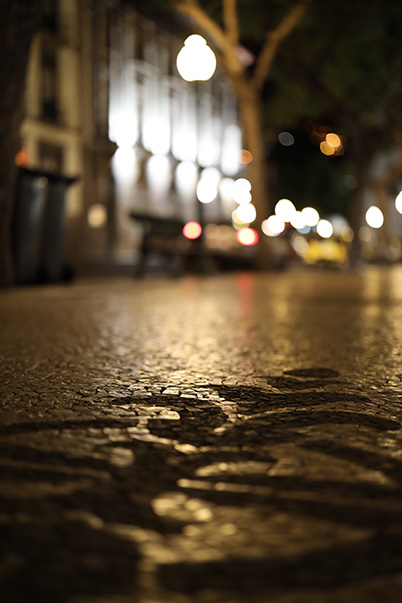I went on a train trip around the town of Interlaken in central Switzerland and took the EOS R with me. Together, we experienced and captured many sights of Switzerland. Here's what I learnt about how to bring out the best in the EOS R. (Reported by: Kazuo Nakahara (Digital Camera Magazine).
Supported by: Jungfrau Railway Group, Rail Europe Japan, Interlaken Tourism

EOS R/ RF24-105mm f/4 L IS USM/ FL: 85mm/ Flexible-priority AE(f/5.6, 1/160 sec, EV±0)/ ISO 2000/ WB:Auto
The Jungfraubahn train. Visitors from all over the world take this red train to the station at Jungfraujoch, which is 3,454m above sea level and known as the Top of Europe. The Eiger and Mönch mountains are in the background. I was pleasantly surprised by how the colours were well-captured although I was shooting in backlight.
#1: Customise the electronic level to toggle on/off with one button press
You will want to ensure that your shot is horizontally straight especially when shooting grand landscapes. This is when displaying the electronic level in the EVF comes in useful—it works even when the scene has no clear lines to help you gauge horizontality.
Tip: Customise the VF info/toggle settings, and you will be able to toggle the electronic level display on and off with a touch of the INFO button.
How to do it

On the SET UP menu tab, go to [Shooting info. Disp.] and then to [VF info/toggle settings]. Choose the items you wish to display for each screen. When you’re done, you will be able to toggle through the screens using the INFO button.

The electronic level helps you to check if you are unknowingly tilting the camera when you shoot, which is especially helpful when the scene has no lines to help you gauge horizontality. If you find it distracting, simply turn it off.

EOS R/ RF24-105mm f/4L IS USM / FL: 24mm / Flexible-priority AE(f/4, 1/800 sec, EV+0.3)/ ISO 100/ WB: Auto
#2: Shooting from a moving vehicle? Apply exposure compensation in advance
It can be hard to find the best exposure when shooting from a moving train/vehicle—the scene just keeps changing. But the constantly-evolving scenery is exactly what makes it tempting to shoot.
Here’s one way to adjust your exposure settings quickly: Customise your controls so that you can simply turn the Quick Control dial or lens control ring to apply exposure compensation. You can see the results applied in real-time in the EVF.

I customised exposure compensation to be controlled by the Quick Control dial in Av and Tv mode. In Fv mode, the dial is used to select the exposure parameter, so I set the lens control ring to be my exposure compensation shortcut instead. The shot below was taken on a train ride between the summits of the Schynige Platte and First.

EOS R/ EF16-35mm f/4L IS USM/ FL: 20mm/ Flexible-priority AE (f/5.6, 1/125 sec, EV+1.0)/ ISO 200/ WB: Auto
#3: Use Large Zone AF to easily achieve focus on large subjects
The AF frame in most AF methods might be too small for large subjects, making it difficult to ensure that the entire subject is in focus.
For such subjects, the two new AF methods on the EOS R are a great help. Large Zone AF (Vertical) and Large Zone AF (Horizontal) both feature AF frames that cover a larger area, making it easier to establish focus not just on large subjects but also subjects that are moving, such as the red paraglider in this scene.

This would have been a rather ordinary scene if not for the paraglider, which is why I decided to incorporate it into my shot. The 'Large Zone AF: Vertical' AF method helped to make sure the entire paraglider was in focus, even with its unpredictable movement.

EOS R/ RF28-70mm f/2L USM/ FL: 28mm/ Flexible-priority AE (f/2, 1/4,000 sec, EV-1.0)/ ISO 200/ WB: Auto
#4: Take advantage of the Vari-angle monitor—capture point-of-view shots
Every travel destination has its “must-take” shots, but how about capturing your own unique perspective on things? With the Vari-angle monitor, this is easier than before. Simply adjust the screen, and you can check and adjust your composition regardless of whether you are holding the camera high above your head for a high-angle shot, or aiming from the ground up at the sky for a super low-angle one.
You no longer need to lie on your stomach to capture that puddle reflection —unless you want to.

When the Vari-angle screen is flipped out, you can rotate it approximately 180° forwards to face the subject, or bend it 90° backwards. The hinges are small but extremely durable, helping to keep the camera body size relatively compact.

EOS R/ RF28-70mm f/2L USM/ FL: 31mm/ Shutter-priority AE (f/2, 1/5,000 sec, EV±0)/ ISO 100/ WB: Auto
Great for vertical shots, even at extreme low angles

Being able to flip out the screen makes it easier to see the shot when shooting in portrait orientation.

(Photo courtesy of Canon)
EOS R/ RF50mm f/1.2L USM/ FL: 50mm/ Aperture-priority AE (f/1.2, 1/25 sec, EV+0.7)/ ISO 400/ WB: Auto
#5: Use an ultra-wide-angle lens and the silent shutter to photograph building interiors
If your favourite EF lens doesn’t have an RF lens equivalent yet, don’t fret. You still can mount them onto the EOS R and harness their full benefits with the EF-EOS R mount adapter. An ultra-wide-angle lens such as the EF16-35mm f/4L IS USM can do wonders for photographing places like church interiors, epecially when paired with the silent shooting feature to preserve the solemn atmosphere of the place.

The RF15-35mm f/2.8L IS USM is a highly-anticipated release, but until it's out, I’m glad to be able to use my EF16-35mm f/4L IS USM with the EOS R with the help of the EF-EOS R mount adapter.

EOS R/ EF16-35mm f/4L IS USM / FL: 20mm / Flexible-priority AE (f/5.6, 1/125 sec, EV+1.0)/ ISO 200/ WB: Auto
Summing up: An excellent travel camera that provides uncompromised image quality and mobility
As Canon’s first full-frame mirrorless camera, the EOS R packs imaging prowess (such as the 30.3-megapixel image sensor, Dual Pixel CMOS AF system and the new DIGIC 8 image processor) and user-friendly features such as the Vari-angle monitor and smartphone pairing capabilities into a relatively small, lightweight body. Much has also said about the new RF mount system and how it revolutionises imaging. For these reasons, I can’t help but feel that the EOS R makes an excellent travel camera, especially when paired with the versatile RF24-105mm f/4L IS USM zoom lens.
For more about the EOS R as a travel camera, read:
Hands-On Review: Why the EOS R is a Good Addition to My Travel Photography Kit
EOS R Hands-on Review: Capturing the Beauty of Japan
24 hours in Seoul: 10 Captivating Photos Shot with the EOS R
Find out more about the EOS R at:
In Focus: EOS R
The EOS R Collection
Receive the latest update on photography news, tips and tricks.
Be part of the SNAPSHOT Community.
Sign Up Now!About the Author
A monthly magazine that believes that enjoyment of photography will increase the more one learns about camera functions. It delivers news on the latest cameras and features and regularly introduces various photography techniques.
Published by Impress Corporation
Born in Hokkaido in 1982, Nakahara turned to photography after working at a chemical manufacturing company. He majored in photography at the Vantan Design Institute and is a lecturer for photography workshops and seminars, in addition to working in commercial photography. He is also a representative of the photography information website studio9.





































